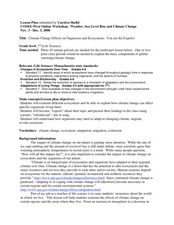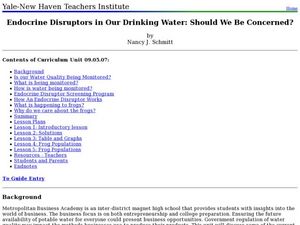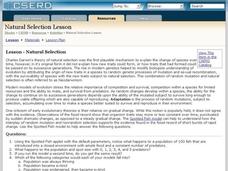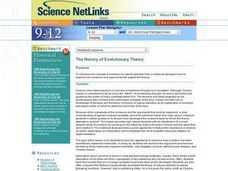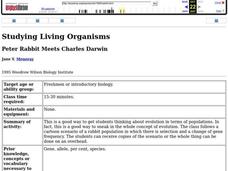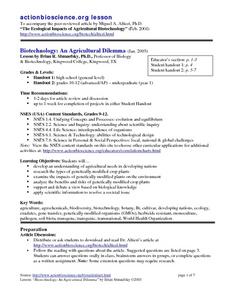Curated OER
Digging Into Science Lesson Plans
In this biology worksheet, students identify and write the various species that are still present today. Then they define evolution using three words. Students also describe what a fossil is and give some examples related to a particular...
Curated OER
Climate Change Effects on Organisms and Ecosystems: You are the Experts!
Seventh graders research about the effect of climate on different ecosystems. In this life science lesson, 7th graders present their research by creating a poster, infomercial, skit or song. They discuss how organisms adapt to climate...
Curated OER
Endocrine Disruptors in Our Drinking Water: Should We Be Concerned?
Young scholars investigate the different hormone contaminants in the water supply. In this math lesson, students analyze data tables and graphs. They demonstrate exponential growth and decay using frog populations.
Curated OER
Molecular Evolution in Plants
Students examine chlorophylls. They explore the absorbing pigments in a variety of plants. Through activities, students determine spectrophotometrically. They compare plant proteins from the family Brassicace to assess the level of...
Curated OER
Biology: Natural Selection
Students explore evolutionary processes and theories using the spotted fish applet. They observe what happens to fish in a closed environment with both food and predators. Students run the model several times and answer questions about...
Curated OER
Why Cladistics?
Students explore how biological classification is intimately associated with evolution.
Curated OER
Pseudogene Suite
Students use Biology Workbench to explore DNA sequence data for the GULOP gene in humans, chimpanzees, orangutans, and crab-eating macaques and the beta globin gene and its pseduogene in humans, gorillas, and chimpanzees.
Curated OER
The History of Evolutionary Theory
Learners are introduced to the concept of evolution by natural selection from a historical standpoint. They examine the evidence and arguments that support the theory of natural selection.
Curated OER
Natural Selection
Students construct a working definition of the word "evolution," and list the key points of Darwin's theory of natural selection. They create paper moths to help them explain the importance of camouflage and how it relates to natural...
Curated OER
Peter Rabbit Meets Charles Darwin
Ninth graders explore evolution. They study a cartoon scenario of a rabbit population in which there is selection and a change of gene frequency. Students discuss frequencies, evolution, and speciation.
Curated OER
Biotechnology: An Agricultural Dilemma
Students investigate the types of genetically modified crop plants there are and the benefits and risks of such plants. The agricultural needs in developing nations for this biological knowledge to resolve societal issues is also...
Curated OER
Electrophoretic Analysis: DNA Fingerprinting and Evolutionary Divergence
Young scholars examine the principles of electrophoresis. They evaluate both the agarose and polyacrylamide system of molecular separation. In order to bring the concepts of genetics and evolution full circle from DNA to protein,...
Curated OER
Fish Parasite Survey
Students count nematodes, cestodes and crustaceans on approximately one-hundred and fifty fish. They fill out autopsy reports for external and internal parasites then complete and discuss guide questions to make inferences about parasite...
Curated OER
Nitrogen Fixation, OR What a Gas!
Young scholars illustrate the adaptation and co-evolution of organisms. They examine set up an experiment to determine the effect of adding the Rhizobium bacteria to a group of legume seeds.
Stanford University
Scopes Trial
Students review information about religious movements in the United States. In this Butler Act instructional activity, students view a video and read in their textbook about the Butler Act. Students review documents about the Scopes...
Curated OER
Constructing a Phylogenetic Tree
Students are given the opportunity to analyze DNA sequence differences between organisms in order to establish a reasonable picture of the evolutionary relationships between them (Phylogenetic Tree). In the simulation form they are...
Curated OER
Spider Activities, Experiments and Projects
Students examine seven spiders and put them into two or three groups based on their structural similarities. In groups, they create a cladogram proposing possible ancestral relationships. Students design an experiment related to their...
Curated OER
Superbugs and Antibiotic Resistance
Students complete experiments on antibiotics and antimicrobials. In groups, they explain how antibiotics affect the evolution of microorganisms. They test various types of bacteria to discover how much resistance they have to antibiotics.
Virginia Department of Education
The Effects of Heat and Acid on the Enzyme Catalase
How quickly do enzymatic reactions occur? Assist the class as they examine heat and pH change to determine the rate of chemical reactions using catalase as an enzyme. Watch them "glow" with excitement!
Curated OER
Studying Fossils
Students study the Evolution in the Light of Fossils. Activities in this lesson range from quantitative measurements of hominoid skulls to the comparison of hominoid bone structures. They hypothesize dinosaur size and speed by looking at...
Curated OER
Lake Superior Ecology Unit
Sixth graders research Lake Superior and its ecosystem. Students investigate the lake's cycles of mixing and stratification and how these cycles affect the biology of the lake. This lesson plan contains five days of activities.
Curated OER
Who's the Baddest?
Students are introduced to the realm of social insects, their role in the environment and the biological features that make them unique.
Curated OER
Beans and Birds: A Natural Selection Simulation
Students examine the problem concerning the evolution of seed color in pinto bean plants "How does natural selection change the frequency of genes or traits over many generations"? Students work in teams to design an experiment that...
Curated OER
Exploring Organisms
Students investigate various organisms in an attempt to understand the process of evolution and related ecological issues. This elementary lesson uses small plastic animals and includes a worksheet for student assessment and reflection.



